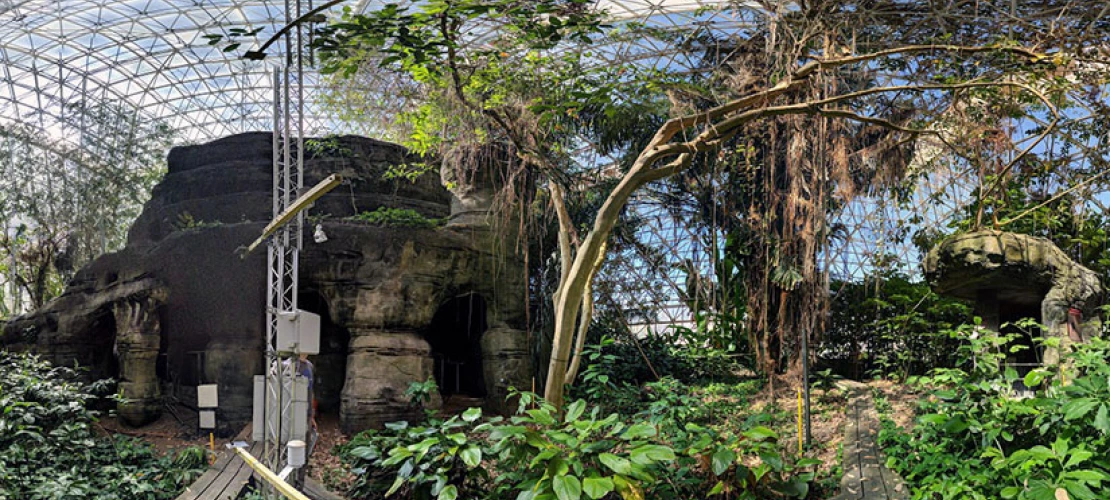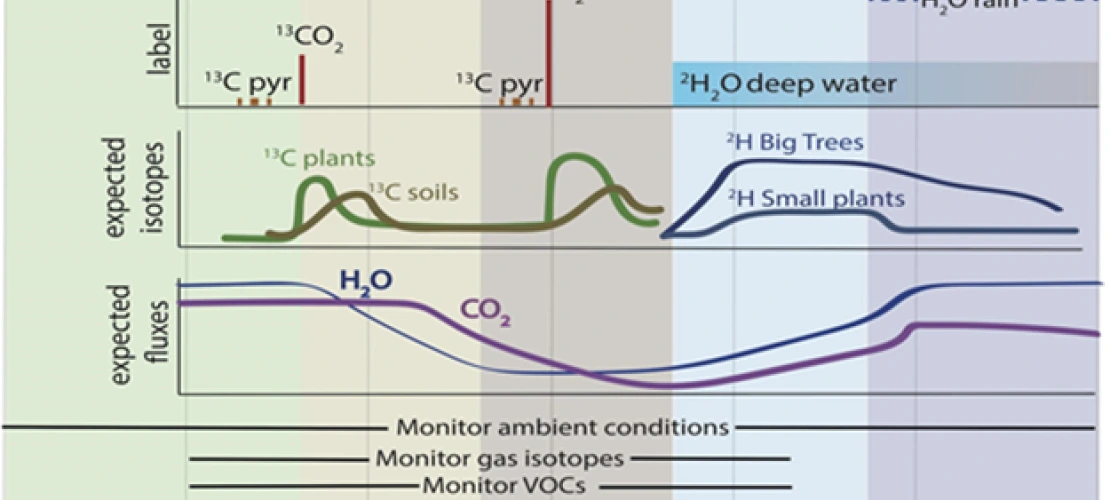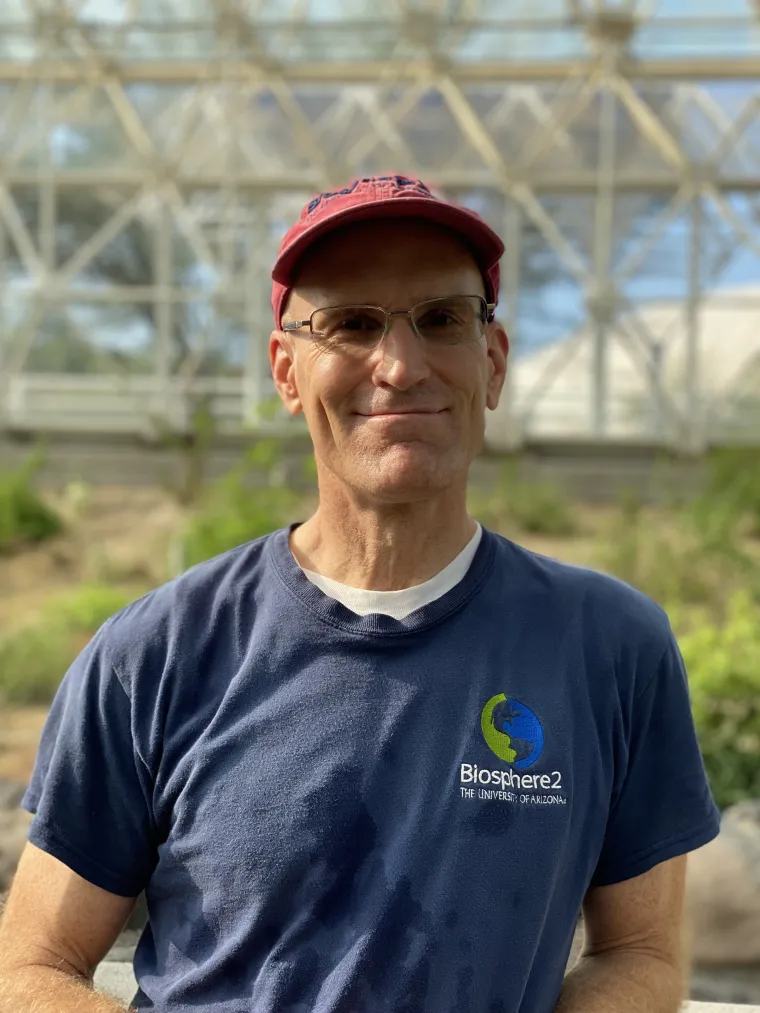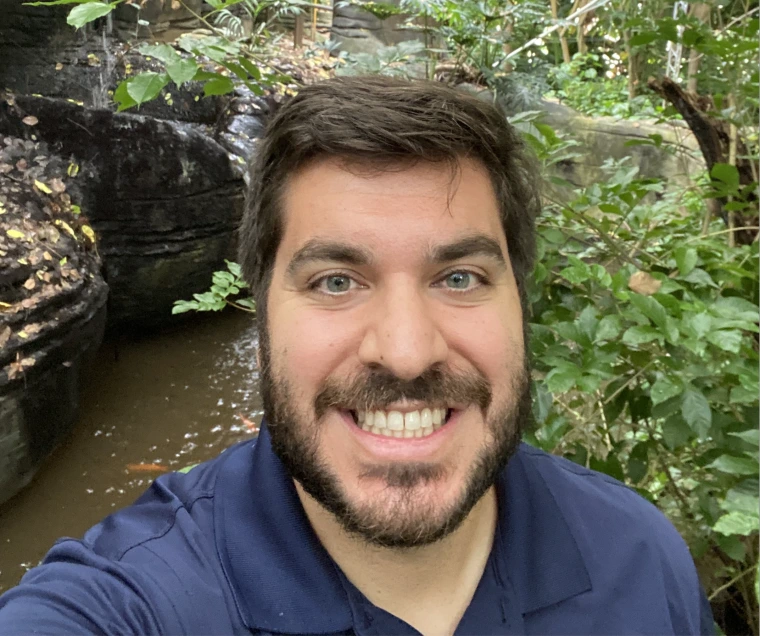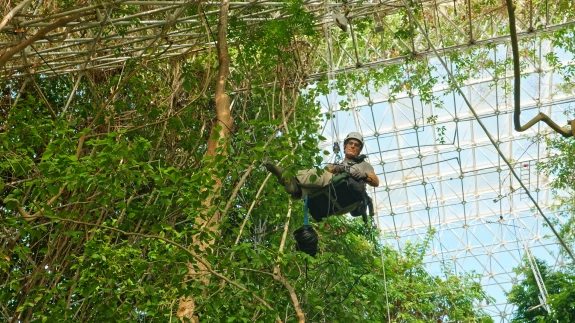
Current Experiment: Exploring the thermal limits of tropical forest canopy leaves
Climate change will increase temperatures across the global and even along the equator temperatures are expected to rise 4-6 oC (~8-12 oF) over the next 100 years. Tropical forests represent the largest natural store of carbon of any ecosystem. Several research studies have suggested that tropical forests are already at their temperature limit, which will result in less carbon uptake by tropical forests in the future. If true, this will accelerate CO2 air concentrations even more than just human activities.
The Biosphere 2 rainforest, because it is enclosed in a glass and metal structure, represents the hottest tropical rain forest canopy on Earth. Air temperatures as high as 58 oC (137 oF) have been measured in the canopy inside Biosphere 2. Canopy air temperatures in the Amazon basin never reach higher than 42 oC (108 oF) in comparison and leaf temperatures rarely get higher than 50 oC (122 oF). The mountain inside Biosphere 2 also provides a perfect structure to expose trees of understory species (including Theobroma cacao and Coffea arabica, the plants that we create chocolate and coffee from) to temperatures that they would be exposed to in the future.
Over the summer of 2024 we did two experiments: 1) a multiple species fluorescence survey with temperature, and 2) a four day heating experiment of mountain and rainforest top.
For the first experiment we borrowed three Walz Micro-PAM sensors from Todd Kana and Bay Instruments, LLC, Easton, MD. These sensors measure the leaf temperature, air humidity, light intensity, and give the leaf a pulse of light after which it measures the Chlorophyll fluorescence -an indication of the health of the photosynthesis system in a leaf.
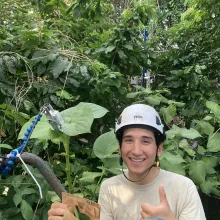
NSF REU student Andrew Hernandez just finished installing a Mini-PAM sensor on a Piper auritum leaf at the top of the rainforest mountain.
Joost van Haren
Together with Andrew Hernandez -a NSF funded undergraduate student, Jason de Leeuw and Joost van Haren moved the sensors every four days to be able to measure daily fluctuations in leaf fluorescence in six species (Annona muicata, Clitoria fairchildiania, Coffea arabica, Pachira aquatica, Piper auritum, and Theobroma cacao) at multiple different temperature exposures. The highest leaf temperature measured with a Mini-PAM sensor was 50.3 oC on a P. aquatica leaf. Although we are still analyzing the data, initial analysis suggests that the photosynthetic apparatus of more high temperature exposed leaves from the same species maintain photosystem II activity to much higher temperatures (>5 oC). Furthermore, the electron transport rate (ETR) is mainly affected by high light conditions, though there is a noticeable drop of ETR at temperatures >45 oC. The leaf that experienced the highest leaf temperature, is the only one that showed a noticeable decrease in the dark adapted Fv/Fm, which fully recovered in a few days. Their initial results suggest that leaves from the measured tropical tree species can recover from temporary heat stress.
The second experiment was a four day heating of the upper canopy and we then monitored the leaf temperature, sap flux rates and leaf critical temperature and water potential. We conducted this experiment with Kevin Hultine, Susan Bush, Jessica Guo, and Madeline Moran from the Desert Botanical Gardens in Tempe, AZ and Ben Wiebe and Chris Doughty from Northern Arizona University. We taped thin temperature sensors to sun and shade leaves from two Pachira aquatica and two Theobroma cacao leaves at three different height levels in each tree. We installed a sap flux sensor (Edaphi Implexx sensor, Edaphic Scientific, Moorabbin, Australia) and psychrometer (PSY1, ICT, Armidale, Australia) on the trunk of each tree. We also sampled leaves from the same height as where the temperature sensors were installed for water potential and critical temperature measurements with a fluorocam.
During the heating part of the experiment canopy temperatures reached as high as 56 oC and after four days the young P. aquatica and T. cacao leaves started to show wilting and some browned up. For the rest the trees appeared to weather temperatures >50 oC much better than we humans did. When we had to sample Jason had brought up an cooler full of ice to help us cool down every 5-10 minutes. We will keep you posted on our upcoming results.
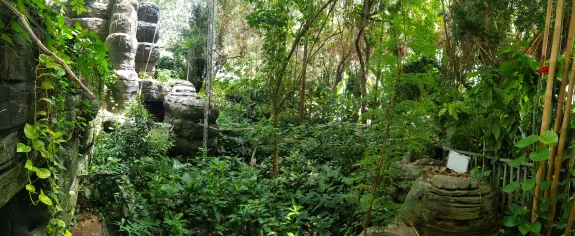
Current Experiment: Trees as conduits for connecting below ground microbial processes to above ground methane emissions at the Terrestrial Aquatic Interface
The global methane budget is still poorly understood and the emissions from one of the largest natural sources, the Amazon basin, we only know very small bits of. The recent discovery that tree stems can contribute 50% of the total methane ecosystem flux, while nobody has measured tree stems for methane emissions until 5 years ago (Dr. Joost van Haren, Interim Director of Rain Forest Research, was one of the first to start this in the Amazon basin).
The proposal sets out to understand the contribution of tree methane emissions in both a flooded forest and an upland forest. We already have an eddy covariance tower in the upland forest and we are going to add methane emissions to that and we plan to construct a varzea tower in the next year (the current Brazil trip was to find a suitable location for that tower).
At Biosphere 2, Dr. van Haren will work with students to test out the automated stem and soil/water surface measurement system. These systems are complicated, because the forest floods with at least 5 feet of water every wet season and the measurement system cannot allow any water to enter into the tubing and machines. The automated stem and soil/water surface measurements have to float up and down with the water level, but still create a secure seal with the surface they are measuring from. The Biosphere 2 varzea area, which can be flooded, is the ideal place to test these systems out before they are brought to Brazil, where technical modification are much harder to do.
2019 Rain Forest Water, Air, and Life Dynamics (WALD) Experiment
The Biosphere 2 Water, Atmosphere, and Life Dynamics (B2 WALD, Wald = forest in German) campaign will leverage Biosphere 2 Tropical Rain Forest (B2 TRF) experimental capabilities to investigate mechanisms that underlie plant-soil-microbe relationships using whole ecosystem stable carbon and water isotope labelling across drought and rewet conditions. The overarching aim of B2 WALD is to fully track, from molecules to the ecosystem, mechanisms driving the fate of carbon and water in forest systems under drought. We will place particular focus on diverse volatile and nonvolatile carbon metabolites, their role in plant and microbial C allocation, and potential to reveal underlying mechanisms. Extensive instrumentation is needed to monitor all ecosystem components (atmosphere, soil, leaves) including multiple gas analyzers for key species (e.g., 13C-CO2 and VOCs). To achieve our scientific aim, we have engaged an international team of scientists with enthusiasm for integrated, transdisciplinary research.
This campaign is centered on Prof. Dr. Christiane Werner’s EUR 1.9M European Research Council (ERC) Consolidator Grant entitled “Biochemical link between plant volatile organic compound (VOC) emissions and CO2 metabolism - from sub-molecular to ecosystem scales”. It is co-led with Biosphere 2 Tropical Rain Forest Director Prof. Dr. Laura Meredith (Assistant Professor, University of Arizona, Tucson). The overall goal of the grant is to develop a novel technological and theoretical basis to couple CO2 fluxes with VOC emissions that will establish mechanistic links between primary and secondary carbon metabolism in plants.
The Werner Group has demonstrated the application of cutting-edge technology (δ13CO2 laser spectroscopy, high sensitivity PTR-TOF-MS and quantitative isotopic NMR spectroscopy) to characterize real-time carbon allocation into VOCs and CO2 using plant position-specific 13C-pyruvate labelling (labelled at the C1 or C2-carbon position) at the branch scale (Fasbender et al. 2018) and, more recently using entire plants. The final stage of the ERC grant proposed to demonstrate the world-wide first canopy positional labelling in the unique facilities of the tropical rainforest in the Biosphere 2, Arizona, the world’s largest controlled growth facility: the Biosphere 2 Tropical Rain Forest. The B2 TRF is the ideal location for this project because whole-ecosystem fluxes can be measured within the enclosed system, the environment is controlled, and the canopy can be accessed, which enables real-time monitoring of ecosystem and branch-level fluxes. This whole ecosystem labelling experiment is a unique opportunity to assess ecosystem processes – from the atmosphere, biosphere, soil and hydrology. Our methodological approach enables novel insights into all these different ecosystem components. Moreover, the biosphere is the world-wide sole system, where full ecosystem manipulation experiments are possible.
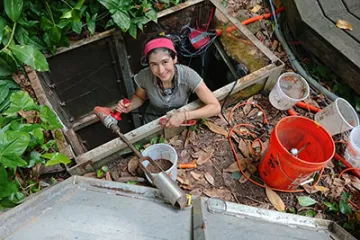
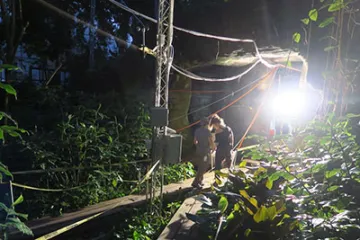
An unprecedented 4-month labelling experiment will be conducted by 1) simulating an ecosystem drought and recovery and 2) bringing in experts and equipment to enable simultaneous measurements of pools and fluxes at the atmosphere, vegetation (phyllosphere, stems), rhizosphere, microbiome and deep water soil processes.
Figure 1. Schematic of B2 Rain Forest Stable Isotope Labelling Experiment timeline including general plans for timing and expectations.
The B2-WALD campaign will be ground-breaking in:
- Tracing pools and fluxes at all levels throughout the ecosystems, disentangling ecosystem processes, interactions and feedbacks to an important climate change driver (drought) from the atmosphere, biosphere (including phyllosphere, rizosphere) and hydrology
- Closing carbon and water budget at an ecosystem scales (in a unique closed facility)
- Partitioning carbon allocation from the molecular to the ecosystems scale
- Integrating metabolomics, genomics, volatilomics into ecosystem fluxes approaches in a truly interdisciplinary manner
- Deconvoluting of the role of deep water reserves, quantifying the role of hydraulic lift by deep rooted trees to ecosystem water budgets by groundwater labelling
The Rain Forest campaign will produce massive amounts of diverse, but integrated, data to paint an exceptional picture of the movement of carbon and water through an ecosystem before, during, and after drought, as a function of diverse biological and abiotic drivers. The stable isotope label applied to ecosystem can be studied in the years to come, asking how long carbon will remain stabilized in the soil for example. Finally, we expect that the high rigor and ambitious scope of this campaign will highlight the unique ability to study the mechanisms underlying emergent ecosystem processes, and one outcome will be to embed this perspective in the minds of scientists and the public.
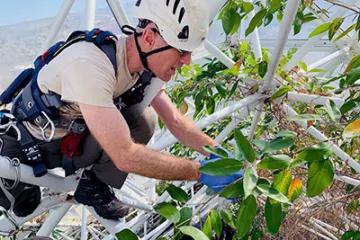
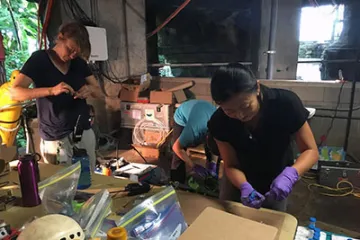
Organization and Management
The campaign is co-led by Christiane Werner (Full Professor, University of Freiburg) and Laura Meredith (B2 Rain Forest Science Director and Assistant Professor, SNRE, UA), with leadership and organization also by Nemiah Ladd (Research Associate and Lecturer, University of Freiburg). The B2 Rain Forest team is led by Laura Meredith and includes John Adams (Deputy Director), Joost van Haren (Asst. Research Professor), and Jason Deleeuw (Research Specialist), with participation from additional B2 staff based on topic.
Committed Participation and Contributions
Partners
This will be a large-scale, international research campaign, led by the ERC-team based at the UA Biosphere 2 that will bring in external contributions including personnel, equipment, and research capabilities.
The number of partners currently committed to the campaign, in addition to Biosphere 2 team members (6-8), is approximately 50 participants (MS Students to Professors) from 20 research groups and 13 institutions located both US (3 US universities including UA/B2) and EU (10 EU from Germany, Switzerland, Austria, and Scotland).
Our partners have committed instrumentation to enable measurements of fluxes and isotopic signatures of carbon and water cycling across ecosystem scales on a continuous, high frequency basis. This includes major equipment valued at approximately $3.2M ($0.9M from UA; $2.3M external equipment) that will be brought to B2 for the campaign, running 4PTR-TOF-MS and six 13CO2 and 2H2O-lasers in parallel and major equipment valued at approximately $3.1M ($1.6M from UA; $1.5M external equipment) that will be used remotely to analyze samples collected at B2 Collectively, our colleagues and partners have committed around $5M in instrumentation to provide an unparalleled picture of ecosystem C and H2O cycling through the rain forest soil, plants, microbes, and atmosphere during this campaign.
For more information about the WALD project email Dr. Laura Meredith
For more information about the Tropical Rain Forest's research endeavors email Dr. Joost van Haren.


